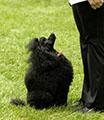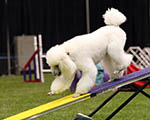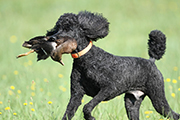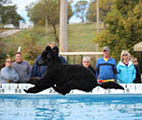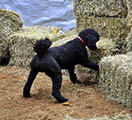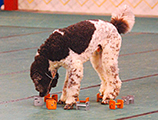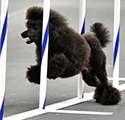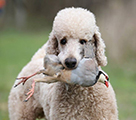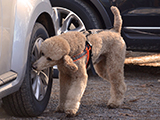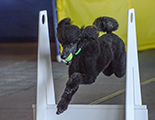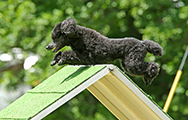So Your Child Wants a Puppy
A child and his dog can form a very special relationship. In most cases, that special relationship doesn’t just happen; it requires careful planning and guidance by parents. What can you do to make sure that adorable Poodle puppy becomes a much-loved companion to your child?
First, make sure that you are ready to take care of a puppy. Children cannot be relied upon to provide 100 percent of the care a puppy will require. Purchase your puppy from a responsible breeder who breeds for a healthy temperament and properly socializes her puppies. You will need to continue to socialize the puppy and take it to puppy and obedience classes. Get the kids involved! Understand why dog bites to children occur and learn how to prevent them. Finally, never leave a small child alone with any dog. These topics are discussed in more detail below.
Purchase your puppy from a responsible breeder who breeds for a healthy temperament and properly socializes her puppies. Temperament should be the primary consideration in selecting a puppy for a family with children. A dog’s temperament is established first by inheritance and then by its experiences. Some breeds, and some lines within breeds, may be better suited to life with children. A responsible breeder will select breeding stock with good temperament in mind, choosing dogs that are tolerant, friendly and trainable. She will then ensure that puppies receive the early socialization required to reinforce that temperament. What attributes should you be you looking for in a puppy that will live with children?
- The puppy should not be shy or nervous with new people or experiences.
- He should be comfortable with people of all ages.
- He should not be overly prey driven. Children move quickly and suddenly just like a prey animal. While it is normal for puppies to follow people as they walk past, you don’t want a dog that will be driven to chase the kids.
- You do want a dog that will be easy to train and willing to take commands from children.
An experienced breeder will pick the puppy from her litter that is best suited to your family. It is likely that a Toy Poodle will not be suitable for an active family with small children. Most responsible Toy Poodle breeders do not sell their dogs to families with small children because of the fragility of the dog.
Continue to socialize the puppy. Your puppy is constantly learning. It is your job to make sure that he learns the proper lessons. Introduce the puppy to as many new people, places and things as you can. You may need to carry him in some places until he has been fully vaccinated (check with your veterinarian on this). Gently handle the puppy’s feet, ears and mouth several times a day. Have your children gently pet and handle the puppy as well. You want a dog that will not be disturbed by little hands (or the veterinarian or groomer!) touching him. Don’t let the puppy learn to guard resources. Occasionally, come up and quietly add food to his dish and/or pet him as he eats (adults only). It is imperative that you teach your children not to disturb a dog while it eats or sleeps. Other dogs might not be as well trained as your own and may be distressed by a small, fast moving, noisy child headed toward their food dish. Teach bite inhibition so the puppy learns not to mouth humans.
Take your puppy to puppy class and continue with obedience training. In most areas it is now possible to find classes aimed at young puppies less than 4 months of age. These classes promote appropriate play between puppies, teach basic manners (sit, down and loose leash walking), and are a great source for advice on house training, etc. If these classes are taught indoors at a clean facility, they are usually appropriate for puppies that are not fully vaccinated. Consult with your vet about what the puppy can do before receiving his last set of shots. Choose an instructor that allows age-appropriate participation by children. Continue with at least one, and preferably more, obedience classes after the initial puppy class.
Get the kids involved. Remember that children aged five and under require constant hands-on supervision around dogs. Older children may be able to play safely with the dog in a fenced yard with less direct supervision. Younger children can learn how to pet safely and gently and might be able to participate in games and training with your guidance. Older children can help with feeding, grooming, exercising, and yes, yard clean up, in addition to training and playing with the dog.
Fun Games:
- Bubble Blaster: Have the child blow bubbles (use only non-toxic solution) in the air near the dog. Many dogs love to chase and pop the bubbles! Chasing the water from the end of a garden hose or sprinkler will also keep a puppy and child happily occupied.
- Hide and Seek: Have the child hide and then send the dog to find the child. Make sure to include the child’s name in your command (“Find Timmy!”). Have the child make a big happy fuss when the dog finds him; the child must resist the temptation to jump out and say “boo” when the dog finds him. You should start this off very simply, with the child “hiding” in plain sight (such as behind an open door or under a table) and calling the dog. Gradually increase the difficulty until the child is hiding in another room. Teach your child about hiding only in places that are safe for both himself and the dog.
- Recall Games: While you hold your dog in place, have the child go across the room. Then have the child call the puppy. Again, praise heavily when the puppy comes. Another recall game involves two or more people sitting on the ground with the puppy in the middle. Call the puppy first to one person, then to another. Be sure that the person calling the dog praises every time the puppy comes.
- Fetch: Train the puppy to retrieve balls or toys that are large enough to not pose a choking hazard. Make sure the child understands that the puppy is not allowed to play keep away. Either the puppy brings the ball back to the child or the game is over. Fetch is usually a very easy game to teach since throwing the ball again as soon puppy returns it is a built-in reward. Make sure to praise every time the puppy returns the ball.
Your child and the puppy will likely find more games to play. Make sure the games are properly supervised. Stop the games if either the puppy or the child gets too excited. Do not have children play tugging or wrestling games with dogs as these may encourage aggression. Also, make sure the games don’t involve chasing the puppy. You don’t want to encourage the puppy to run away from people! Games that encourage the puppy to chase children should also be discouraged as chasing can bring out prey behavior that may lead to the child being nipped.
Dog Activities Designed for Children:
- American Kennel Club (AKC) “Kid’s Corner” and Educational Resources. The AKC publishes “Kid’s Corner,” a newsletter dedicated to educating elementary school children about responsible dog ownership. “Kid’s Corner” can be read online at www.akc.org or can be downloaded and printed. The AKC website also has an extensive set of activity sheets for children that again emphasize responsible dog ownership as well as resources for teaching safety around dogs.
- Junior Showmanship and Junior Recognition Certificate. In the AKC Junior Showmanship program, children from age nine to eighteen compete in AKC events against other children their own age, where they are judged on their ability to properly present, or handle, their dogs. The AKC will award special Junior Recognition Certificates to children who register and earn titles in performance events. Children enter obedience, agility, rally, tracking, or other performance events where they compete in the regular classes, or the field, along with all other exhibitors at the trial. They earn the same titles as all other exhibitors. The Canadian Kennel Club (CKC) and the United Kennel Club (UKC) have their own rules for juniors showing in conformation and performance events. While junior handling can involve a significant time commitment, it is also a rewarding family activity. Juniors learn training skills, develop self-confidence and learn good showmanship. The dog receives the care and training that goes into producing a happy and stable dog, just what you need in a family pet.
- 4-H is a youth organization with more than 6 million members in over 80 countries around the world. Many areas offer canine projects. In the United States, 4-H is open to children between the ages of five and nineteen, depending on the area. Many counties have a strong 4-H program. Specific projects such as Dog Care and Training may be offered depending on the interest in the community. Information about 4-H can be obtained from your local County Extension Service or at https://4-h.org.
Keep Your Children Safe Around Dogs:
Babies and pre-schoolers should NEVER be left alone with any dog or puppy. All young children should always be closely supervised by an adult when around any dog or puppy. An older child may not require hands-on supervision around the family dog; this decision should be made by the parents based on the behavior of both the child and the dog. Most serious dog bites are to children under age five; therefore, supervision and training are critical. For more information on safe interactions between kids and dogs, see:
https://www.apps.akc.org/apps/kids_juniors/index.cfm?nav_area=kids_juniors or
https://doggonesafe.com/Dog_Owner_Bite_Prevention.
Common Sense Guidelines for Children and Dogs:
- Teach your children to never approach a strange dog without first obtaining your permission and then the owner’s permission. Don’t let your children approach a loose dog. Teach your children how to act like a tree when approached by a strange dog; they should be quiet, not move, tuck their hands into their armpits, and not make eye contact with the dog. Most dogs find this boring and will wander off.
- Teach your children not to pet your dog when he is indicating that he doesn’t want their attention. A dog’s signal that he isn’t interested may initially be as subtle (to us) as walking away. If the child continues to follow, the dog may lift his lip and then progress to growling. Failure to heed such signals may lead a dog to conclude he has no choice but to bite. Young children may not be able to read these signals. Always supervise their interactions with the dog.
- Teach your children to pet gently and not grab at any dog, including your own.
- Teach your children not to put their faces near any dog’s face, including your own. Teach them not to hug or kiss dogs. Very few dogs enjoy being hugged or kissed.
- Teach your children how and when to pick up a puppy. You will need to judge whether your child is old enough to safely hold onto a squirming puppy. You may want to tell children under nine years of age not to pick up the puppy unless they are seated on the floor.
- Teach your children to be calm and quiet around dogs. There should be no running or other fast movements and no loud noises.
- Teach your children not to bother a dog when he is sleeping or eating. Also teach them not to go into the dog’s crate or poke their fingers or any other objects into the crate when the dog is inside.
- Teach your children not to share their food with the dog. Do not allow the dog to steal food from children. Children should also be taught how to properly use treats when training the dog and how to properly fill the dog’s bowl.
- Train and socialize your dog. He should be well-mannered even if the children occasionally forget the rules. If you see behaviors that concern you, contact a professional trainer with experience dealing with behavioral problems in dogs.
The information contained in these documents is current at the time of this writing and is accurate to the best of VIP’s knowledge.
This information has been provided to you at no charge. You are free to use it provided it is used in its entirety with no changes or alterations and that the copyright remains intact. If you have found this information to be helpful, please consider making a tax-deductible donation to:
Versatility in Poodles
4061 Highlands Rd
Franklin, NC 28734
To make a donation via PayPal, please click the Donate Button:
![]()
The contents of the www.vipoodle.org website, such as text, graphics, images, and other material contained on this site (“Content”) are for informational purposes only. The Content is not intended to be a substitute for professional veterinarian advice, diagnosis, or treatment. Always seek the advice of your veterinarian with any questions you may have regarding the medical condition of your pet. Never disregard professional advice or delay in seeking it because of something you have read on this website!
If you think your pet has a medical emergency, call or visit your veterinarian or your local veterinary emergency hospital immediately. Versatility in Poodles and www.vipoodle.org do not recommend or endorse any specific veterinarians, products, procedures, opinions, or other information that may be mentioned on this website. Reliance on any information appearing on this website is entirely at your own risk.


